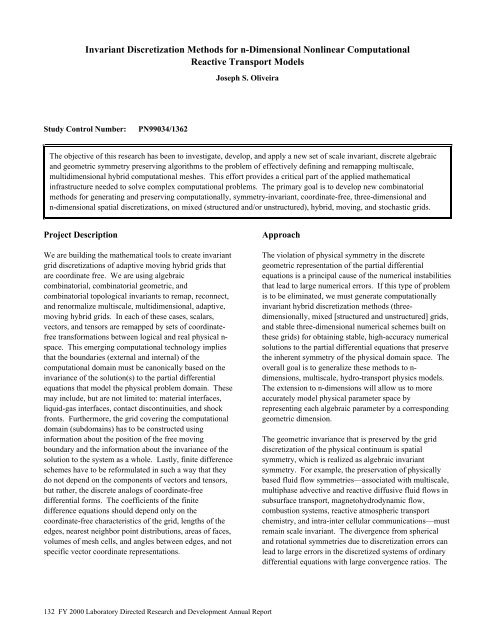PNNL-13501 - Pacific Northwest National Laboratory
PNNL-13501 - Pacific Northwest National Laboratory
PNNL-13501 - Pacific Northwest National Laboratory
You also want an ePaper? Increase the reach of your titles
YUMPU automatically turns print PDFs into web optimized ePapers that Google loves.
Invariant Discretization Methods for n-Dimensional Nonlinear Computational<br />
Reactive Transport Models<br />
Study Control Number: PN99034/1362<br />
Joseph S. Oliveira<br />
The objective of this research has been to investigate, develop, and apply a new set of scale invariant, discrete algebraic<br />
and geometric symmetry preserving algorithms to the problem of effectively defining and remapping multiscale,<br />
multidimensional hybrid computational meshes. This effort provides a critical part of the applied mathematical<br />
infrastructure needed to solve complex computational problems. The primary goal is to develop new combinatorial<br />
methods for generating and preserving computationally, symmetry-invariant, coordinate-free, three-dimensional and<br />
n-dimensional spatial discretizations, on mixed (structured and/or unstructured), hybrid, moving, and stochastic grids.<br />
Project Description<br />
We are building the mathematical tools to create invariant<br />
grid discretizations of adaptive moving hybrid grids that<br />
are coordinate free. We are using algebraic<br />
combinatorial, combinatorial geometric, and<br />
combinatorial topological invariants to remap, reconnect,<br />
and renormalize multiscale, multidimensional, adaptive,<br />
moving hybrid grids. In each of these cases, scalars,<br />
vectors, and tensors are remapped by sets of coordinatefree<br />
transformations between logical and real physical nspace.<br />
This emerging computational technology implies<br />
that the boundaries (external and internal) of the<br />
computational domain must be canonically based on the<br />
invariance of the solution(s) to the partial differential<br />
equations that model the physical problem domain. These<br />
may include, but are not limited to: material interfaces,<br />
liquid-gas interfaces, contact discontinuities, and shock<br />
fronts. Furthermore, the grid covering the computational<br />
domain (subdomains) has to be constructed using<br />
information about the position of the free moving<br />
boundary and the information about the invariance of the<br />
solution to the system as a whole. Lastly, finite difference<br />
schemes have to be reformulated in such a way that they<br />
do not depend on the components of vectors and tensors,<br />
but rather, the discrete analogs of coordinate-free<br />
differential forms. The coefficients of the finite<br />
difference equations should depend only on the<br />
coordinate-free characteristics of the grid, lengths of the<br />
edges, nearest neighbor point distributions, areas of faces,<br />
volumes of mesh cells, and angles between edges, and not<br />
specific vector coordinate representations.<br />
132 FY 2000 <strong>Laboratory</strong> Directed Research and Development Annual Report<br />
Approach<br />
The violation of physical symmetry in the discrete<br />
geometric representation of the partial differential<br />
equations is a principal cause of the numerical instabilities<br />
that lead to large numerical errors. If this type of problem<br />
is to be eliminated, we must generate computationally<br />
invariant hybrid discretization methods (threedimensionally,<br />
mixed [structured and unstructured] grids,<br />
and stable three-dimensional numerical schemes built on<br />
these grids) for obtaining stable, high-accuracy numerical<br />
solutions to the partial differential equations that preserve<br />
the inherent symmetry of the physical domain space. The<br />
overall goal is to generalize these methods to ndimensions,<br />
multiscale, hydro-transport physics models.<br />
The extension to n-dimensions will allow us to more<br />
accurately model physical parameter space by<br />
representing each algebraic parameter by a corresponding<br />
geometric dimension.<br />
The geometric invariance that is preserved by the grid<br />
discretization of the physical continuum is spatial<br />
symmetry, which is realized as algebraic invariant<br />
symmetry. For example, the preservation of physically<br />
based fluid flow symmetries—associated with multiscale,<br />
multiphase advective and reactive diffusive fluid flows in<br />
subsurface transport, magnetohydrodynamic flow,<br />
combustion systems, reactive atmospheric transport<br />
chemistry, and intra-inter cellular communications—must<br />
remain scale invariant. The divergence from spherical<br />
and rotational symmetries due to discretization errors can<br />
lead to large errors in the discretized systems of ordinary<br />
differential equations with large convergence ratios. The

















